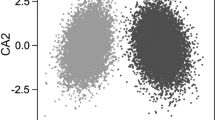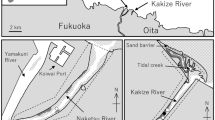Abstract
This study aimed to characterize the food intake by the fish assemblage inhabiting aquatic macrophytes stands, evaluating the changes in food availability among the periods of the hydrologic cycle and the trophic responses of the fish assemblage along with food availability. Fish sampling was conducted in stands of aquatic macrophytes (predominantly Paspalum repens, Poaceae) along banks of the Trombetas River during the four hydrologic periods (rising, high, receding, and low water level) that represent different phenological conditions of the habitat. The food consumption by the fish assemblage was analyzed for 41 species with stomach contents. The assemblage fed mainly on aquatic insects, periphytic algae and detritus. Food availability analysis showed that food resources changed among periods. Fifteen species were present in more than one period and most of those species showed dietary changes along with the hydrologic cycle, feeding mainly on invertebrates in the rising water period and periphytic algae and detritus in receding and low water periods. Only four species showed sufficient numbers to be analyzed in relation to diet and food availability along the at least three hydrologic periods, two of which showed a positive correlation between diet and food availability for three of the four periods; the other two species did not show this correlation, and presented omnivorous habits. In all cases, the selectivity values for the most important food items were near zero, indicating that intake was not motivated by feeding preference. Our results suggest that both trophic plasticity and omnivorous diets are important adaptations for species that inhabit temporally variable habitats such as aquatic macrophytes stands.



Similar content being viewed by others
References
Agostinho AA, Thomaz SM, Gomes LC, Baltar SLSMA (2007) Influence of the macrophyte Eichhornia azurea on fish assemblage of the upper Paraná River floodplain (Brazil). Aquat Ecol 41:611–619
Angermeier PL (1982) Resource seasonality and fish diets in an Illinois stream. Environ Biol Fish 7(3):251–264
Araújo-Lima CARM, Portugal LPS, Ferreira EG (1986) Fish-macrophyte relationship in the Anavilhanas Archipelago, a black water system in the Central Amazon. J Fish Biol 29:1–11
Balcombe SR, Bunn SE, Mckenzie-Smith JF, Davies PM (2005) Variability of fish diets between dry and flood periods in an arid zone floodplain river. J Fish Biol 67:1552–1567
Battle JM, Mihuc TB (2000) Decomposition dynamics of aquatic macrophytes in the lower Atchafalaya large floodplain river. Hydrobiol 418:123–136
Brasil Departamento Nacional da Produção Mineral. Projeto RADAMBRASIL (1976) Folha SA.21 Santarém: geologia. geomorfologia. solos. vegetação e uso potencial da terra. Ministério de Minas e Energia. DNPM/Projeto RADAMBRASIL. Rio de Janeiro. Vol.10. 517p
Casatti L, Mendes HF, Ferreira KM (2003) Aquatic macrophytes as feeding site for small fishes in the Rosana reservoir, Paranapanema River, southeastern Brazil. Braz J Biol 63(2):213–222
Chevin LM, Lande R, Mace GM (2010) Adaptation, plasticity, and extinction in a changing environment: towards a predictive theory. PLoS Biology 8(4):1–8
Correa SB, Crampton WGR, Chapman LJ, Albert JS (2008) A comparison of flooded forest and floating meadow fish assemblages in an upper Amazon floodplain. J Fish Biol 72:629–644
de Souza-Franco GM, Takeda AM (2000) Invertebrates Associated with Paspalum repens (Poaceae) at the Mouth of Caracu Stream (1991–1992), affluent of the Paraná River, Porto Rico - PR – Brazil. Braz Arch Biol Technol 43(3):317–325
Delariva RL, Agostinho AA (2001) Relationship between morphology and diets of six Neotropical loricariids. J Fish Biol 58:832–847
Dvorák J, Best EPH (1982) Macro-invertebrate communities associated with the macrophytes of lake Vechten: structural and functional relationships. Hydrobiol 95:115–126
Elmoor-Loureiro LMA (1997) Manual de Identificação de Cladóceros Límnicos do Brasil. UNIVERSA, Brasília, 156pp
Engle DL, Melack J (1993) Consequences of riverine flooding for seston and the periphyton of flooding meadows in an Amazon floodplain lake. Limnol Oceanogr 38(7):1500–1520
Fugi R, Agostinho AA, Hahn NS (2001) Trophic morphology of five benthic-feeding fish species of a tropical floodplain. Rev Brasil Biol 61(1):27–33
Gaspar da Luz KD, Abujanra F, Agostinho AA, Gomes LC (2001) Caracterização trófica da ictiofauna de três lagoas da planície aluvial do alto rio Paraná, Brasil. Acta Sci 23(2):401–407
Goulding M, Carvalho ML, Ferreira EG (1988) Rio Negro: rich life in poor water—Amazonian diversity and ecology as seen thought fish communities. SPB Academic Publishing, California, 200 pp
Grenouillet G, Pont D, Seip KL (2002) Abundance ad richness as a function of food resources and vegetation structure: juvenile fish assemblages in rivers. Ecography 25:641–650
Guenther M, Bozelli R (2004) Effects of inorganic turbidity on the phytoplankton of an Amazonian Lake impacted by bauxite tailings. Hydrobiol 511:151–159
Higuti J, Velho LFM, Lansac-Toha FA, Martens K (2007) Pleuston communities are buffered from regional flood pulses: the example of ostracods in the Paraná River floodplain, Brazil. Fresh Biol 52:1930–1943
Jones JI, Moss B, Eaton JW, Young JO (2000) Do submerged aquatic plants influence periphyton community composition for the benefit of invertebrate mutualists? Fresh Biol 43:591–604
Junk WJ (1973) Investigations on the ecology and production-biology of the “floating meadows” (Paspalo-Echinochloetum) on the middle Amazon. Part II. The aquatic fauna in the root zone of floating vegetation. Amazoniana 4(1):9–102
Junk WJ, Piedade MTF (1997) Plant life in the floodplain with special reference to herbaceous plants. In: Junk WJ (ed) The Central Amazon Floodplain: ecology of a pulsing system. Ecological Studies. Vol. 126. Springer. Berlin. p 147–185
Kawakami E, Vazzoler G (1980) Método gráfico e estimativa de índice alimentar aplicado no estudo de alimentação de peixes. Bolm Inst Oceanogr 29(2):205–207
Lechowich M (1982) The sampling characteristics of electivity indices. Oecologia 52:22–30
Lopes A, de Paula JA, Mardegan SF, Hamada N, Piedade MTF (2011) Infuência do hábitat na estrutura da comunidade de macroinvertebrados aquáticos associados às raízes de Eichhornia crassipes na região do Lago Catalão, Amazonas, Brasil. Acta Amaz 41(4):493–502
Lowe-McConnell RH (1987) Ecological studies in tropical fish communities. University Press. Cambridge, Cambridge, 382 p
Luz-Agostinho KDG, Bini LM, Fugi R, Agostinho AA, Júlio HF Jr (2006) Food spectrum and trophic structure of the ichthyofauna of Corumbá reservoir, Paraná River Basin, Brazil. Neotrop Ichthyol 4(1):61–68
Meschiatti AJ, Arcifa MS (2002) Early life stages of fish and the relationships with zooplankton in a tropical brazilian reservoir: Lake Monte Alegre. Braz J Biol 62(1):41–50
Meschiatti AJ, Arcifa MS, Fenerich-Verani N (2000) Fish communities associated with macrophytes in Brazilian floodplain lakes. Environ Biol Fish 58:133–143
Neiff JJ, Poi de Neiff A, CanónVerón MB (2009) The role of vegetated areas on fish assemblage of the Paraná River floodplain: effects of different hydrological conditions. Neotrop Ichthyol 7(1):39–48
Pelicice FM, Agostinho AA (2006) Feeding ecology of fishes associated with Egeria spp. patches in a tropical reservoir, Brazil. Ecol Fresh Fish 15:10–19
Persson L, Eklöv P (1995) Prey refuges affecting interactions between piscivorous perch and juvenile perch and roach. Ecology 76(1):70–81
Petry P, Bayley PB, Markle DF (2003) Relationships between fish assemblages, macrophytes and environmental gradients in the Amazon River floodplain. J Fish Biol 63:547–579
Prado KLL, Freitas CEC, Soares MGM (2010) Assembléias de peixes associadas às macróftas aquáticas em lagos de várzea do baixo rio Solimões. Biotemas 23(1):131–142
Prejs A, Prejs K (1987) Feeding of tropical freshwater fishes: seasonality in source availability and resource use. Oecologia 71:397–404
Putz R (1997) Periphyton communities in an Amazonian black and whitewater habitats: community structure, biomass and productivity. Aquat Sci 59:74–93
Sabattini RA (1985) Dinámica y produtividad de Paspalum repens Bergius (canitilho) em um ambiente lenitico del valle aluvial del rio Paraná. Rev Hydrobiol trop 18(1):3–11
Sale P (1974) Overlap in resource use and interspecific competition. Oecologia 17:245–256
Sánchez-Botero JI, Araújo-Lima CARM (2001) As macrófitas como berçário para a ictiofauna da várzea do rio Amazonas. Acta Amaz 31(3):437–447
Sánchez-Botero JI, Leitão RP, Caramaschi EP, Garcez DS (2007) The aquatic macrophytes as refuge, nursery and feeding habitats for freshwater fish from Cabiúnas Lagoon, Restinga de Jurubatiba National Park, Rio de Janeiro, Brazil. Acta Limnol Bras 19(2): 143–153
Santos CL, dos Santos IA, da Silva CJ (2009) Ecologia trófica de peixes ocorrentes em bancos de macróftas aquáticas na baia Caiçara, Pantanal Mato-Grossense. Rev Bras Bioc 7(40):473–476
Thomaz SM, da Cunha ER (2010) The role of macrophytes in habitat structuring in aquatic ecosystems: methods of measurement, causes and consequences on animal assemblages’ composition and biodiversity. Acta Limnol Bras 22(2):218–236
Uieda VS, Pinto TLF (2011) Feeding selectivity of ichthyofauna in a tropical stream: space-time variations in trophic plasticity. Community Ecol 12(1):31–39
Winemiller KO (1989) Ontogenetic diet shifts and resource partitioning among piscivorous fishes in the Venezuellan llanos. Environ Biol Fish 26:177–199
Winemiller KO (1996) Factors driving temporal and spatial variation in aquatic floodplain food web. In: Polis GA, Winemiller KO (eds) Food Webs: integration of patterns and dynamics. Kluwer Academic Publishers, Massachusetts, pp 298–312
Winemiller KO, Kelso-Winemiller LC (1996) Comparative ecology of catfishes of the Upper Zambezi River floodplain. J Fish Biol 49:1043–1061
Winemiller KO, Pianka ER (1990) Organization in natural assemblages of desert lizards and tropical fishes. Ecol Monogr 60:27–55
Zavala-Camim LA (1996) Introdução aos estudos sobre alimentação natural em peixes. Maringá, EDUEM, 129p
Acknowledgments
This work was supported by the Brazilian National Council for Scientific and Technological Development (CNPq) that provided a study grant to CPR and a productivity grant to JZ (process 307464/2009-1); Mineração Rio do Norte provided funding for collecting trips and support for field activities. The study was conducted according to current rules established by INPA’s Ethics Committee in 2012. We are grateful to Tiago H. S. Pires for his comments about the text and helping in English review of the manuscript and to anonymous reviewer provided constructive comments that significantly improved the original manuscript.
Author information
Authors and Affiliations
Corresponding author
Electronic supplementary material
Below is the link to the electronic supplementary material.
Rights and permissions
About this article
Cite this article
Röpke, C.P., Ferreira, E. & Zuanon, J. Seasonal changes in the use of feeding resources by fish in stands of aquatic macrophytes in an Amazonian floodplain, Brazil. Environ Biol Fish 97, 401–414 (2014). https://doi.org/10.1007/s10641-013-0160-4
Received:
Accepted:
Published:
Issue Date:
DOI: https://doi.org/10.1007/s10641-013-0160-4




